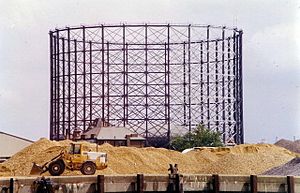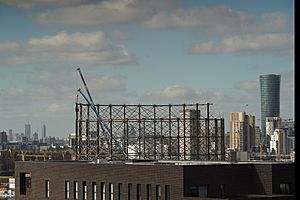East Greenwich Gas Works facts for kids
The East Greenwich Gas Works was a very important factory in London. It was the last and most modern gas factory built in the city. It used to make "town gas" from coal that arrived by river. It also made other things like coke and chemicals. Later, in the 1960s, it started making gas from oil instead. Today, none of the big gas holders are left. The very last one, built in 1886, was taken down in 2020.
Contents
Where Was It?
This huge gas works was built on the Greenwich Peninsula in south-east London. It was right next to the River Thames. Construction happened between 1881 and 1886. Most of the factory was built on new, undeveloped land on the Greenwich Marshes.
How It Started and Grew
The East Greenwich Gas Works was built by the South Metropolitan Gas Company. Its chairman, George Livesey, was in charge of the project. Before building could start, many tons of waste material were dumped. This was done to make the marshy ground firm enough for the heavy factory.
The gas works eventually covered a large part of the Greenwich Peninsula. It stretched for about 2 kilometers (1.2 miles) and covered around 240 acres (1 square kilometer). The factory also took over an existing chemical works nearby. This chemical works already used materials like tar and ammonia from other gas factories.
Working at the Gas Works
In 1889, there was a time of worker disagreements, including a big dock strike in London. At the gas works, many workers quit their jobs all at once. They were trying to stop a new plan that linked their pay to company profits, but also had rules against strikes. However, George Livesey successfully brought in new workers from outside to replace them.
Giant Gas Holders
The site had two very large gas holders. These were huge containers used to store the gas.
- The first one, built in 1886, could hold 8.6 million cubic feet of gas. It was the world's first "four lift" holder, meaning it had four moving sections.
- The second one was even bigger, with six lifts. It was originally the largest in the world, holding 12.2 million cubic feet of gas.
This second holder was damaged by an explosion in 1917. Its size was reduced to 8.9 million cubic feet. It was still the largest in England until it was damaged again by a bomb in 1978. After that, it was taken down.
The gas works also had a large internal railway system. This system carried coal from a big pier on the river to different parts of the factory.
Research and Changes
In the 1920s, a special Government Fuel Research Station was built next to the gas works. This station studied how to turn coal into petroleum. It also checked the properties of different types of coal. This research station closed in 1958.
In 1949, the gas industry in Britain became owned by the government. The East Greenwich plant was then taken over by the South Eastern Gas Board. Later, it became part of British Gas plc.
In the early 1960s, new equipment was added to make gas from oil. This greatly increased how much gas the factory could produce. In 1965, the site made about 400 million cubic feet of gas. This made it the largest gas-producing site in the world.
However, after North Sea gas was discovered and became widely used, the factory stopped making gas in 1976. The oil gasification equipment was kept for many years, but eventually it was also taken down.
A unique concrete building at Phoenix Wharf was used to store a chemical called ammonium sulphate. This building had a cool curved roof. In the 1990s, it was used for filming movies and TV shows, like the detective series Dempsey and Makepeace. It was later taken down.
Cleaning Up and Building New Things
The land where the gas works stood needed a lot of cleaning up. This process is called "decontamination." Workers had to dig deep to remove tar from the ground. They also removed about 120 tons of harmful chemicals like benzene.
New building started in the early 1990s. The North Greenwich tube station was built as part of the Jubilee Line Extension. Because of this new station, the site was chosen for the Millennium Dome. This dome was meant to be temporary, but it is now The O2 Arena.
Today, the area is home to many new developments:
- The O2
- North Greenwich Underground station
- A shopping area and cinema
- A hotel
- A primary school
- Greenwich Peninsula Ecology Park (a nature park)
- Greenwich Millennium Village (a housing area)
Two small parts of the old coaling pier are still there as part of North Greenwich Pier. One of these parts is now the base for a sculpture called Quantum Cloud by Anthony Gormley.
Taking Down the Last Gas Holder
In July 2019, work began to take down the last gas holder at East Greenwich Gas Works. From February 2020, the outer metal frame was carefully removed.
See also
- Beckton Gas Works
- Southall Gas Works
- Imperial Gas Works, Fulham
- Nine Elms Gas Works



